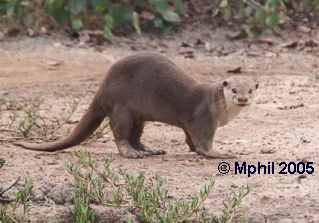Appearance and Anatomy of the Smooth-Coated Otter
The information below comes from
Bree (1968)a, Bree
(1968)b, Harris
(1968), Dr
Gerard F. Willemsen and Hayman
(1956) Special thanks to J.A. Davis, who let me use his copyright species
identification image, Dr. Christopher J. Yahnke, University of Wisconsin
- Stevens Point, for allowing the use of the skull image, and MPhil for the
fine photo of an adult male Smooth-Coated Otter, from Pulau Ubin, Singapore
(click on it for larger version).
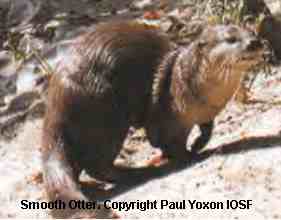 Summary
Summary
This is an average sized, robustly built otter, with a rounded head and large feet.
Size
| Sex | Total Length | Tail | Weight |
| Both | 107 - 130cm (42 - 51") |
40 - 50cm (16- 20") |
7 - 12g (16- 25lb) |
This species displays some sexual dimorphism - females tend to be slightly smaller. There seems to be some evidence that animals in Bhutan (BREE 1968) are larger than those of the Sundarbans, and those in the Sind are smaller.
Head and Teeth
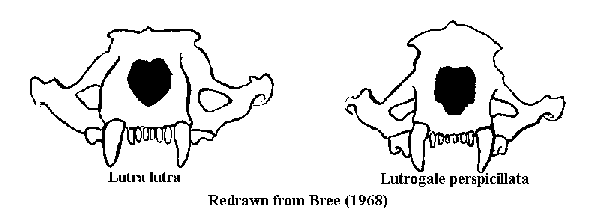
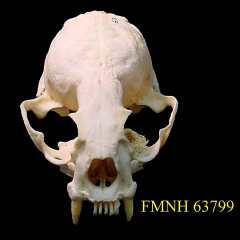 Compared to Eurasian
Otters, the Smooth Otter has a high domed skull, with the eyes set more forward
and wider spaced. The muzzle is also shorter than in the Eurasian otter,
although the actual length of the skull is about the same in both species.
In fact, the Smooth Otter's face is quite similar to that of the Asian Small-Clawed
Otter. The rhinarium is large, prominant and unfurred, resembling a rather
flattened diamond. The nostrils are widely set, on the lower edges of the
rhinarium (see C in the block illustration).
Compared to Eurasian
Otters, the Smooth Otter has a high domed skull, with the eyes set more forward
and wider spaced. The muzzle is also shorter than in the Eurasian otter,
although the actual length of the skull is about the same in both species.
In fact, the Smooth Otter's face is quite similar to that of the Asian Small-Clawed
Otter. The rhinarium is large, prominant and unfurred, resembling a rather
flattened diamond. The nostrils are widely set, on the lower edges of the
rhinarium (see C in the block illustration).
The teeth are more robust than those of the Eurasian Otter, with broad molars and massive, four-sided premolars for crushing food. The canines are about the same size as those of the Eurasian Otter, and shearing surfaces are also present on the premolars, so they are also equiped for catching and slicing. The dental formula is
Body
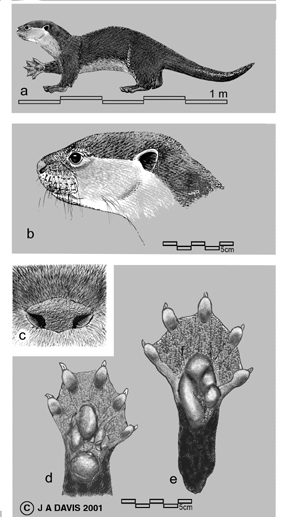 The Smooth Otter has the classical
otter shape, but is larger and more heavily-built than the Eurasian
Otter. It is a lean animal, carrying little body fat. The female
has four teats, as is usual with otters. The male baculum is baseball-bat
shaped, ending is a bilobal distal process. The animals have a pair
of anal scent glands, which produce a liquid which is added to spraint,
and is almost certainly conveys information about sex, sexual state
and receptivity, and maybe identity.
The Smooth Otter has the classical
otter shape, but is larger and more heavily-built than the Eurasian
Otter. It is a lean animal, carrying little body fat. The female
has four teats, as is usual with otters. The male baculum is baseball-bat
shaped, ending is a bilobal distal process. The animals have a pair
of anal scent glands, which produce a liquid which is added to spraint,
and is almost certainly conveys information about sex, sexual state
and receptivity, and maybe identity.
Tail
The tail of this species is quite flattened underneath, almost triangular in section.Legs and Paws
The paws of this species are large in proportion to its body. The strong webbing does not extend to the third phalange, and the claws, although strong, are quite short - this animal has better manual dexterity than a Eurasian Otter, being able to manipulate quite small objects.Fur
The fur from which the Smooth Otter gets its name is shorter than that of other otters, and velvety in appearance when dry. The guard hairs are 12-14mm (about 1/2 inch), and the underfur is only 6 - 8mm (1/4 inch) long, and densely packed.Generally the coat is brown, the underside pale and the throat paler. The actual shade of brown varies in different areas - otters of the Sind are tawny to sandy brown, while the now-extinct Iraqi subspecies was the colour of good plain chocolate, very little paler on the underside, with an iron-grey throat (this can be seen in the photographs of Mijbil in "Ring of Bright Water"). Apart from these extremes, the otters vary from raw umber, through chestnut to smoky gray-brown, with lighter bellies and yellow to white throats.
| Smooth-Coated Otter |


